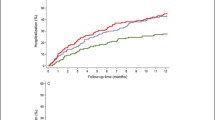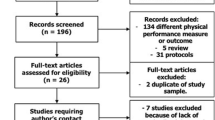Abstract
Background and aims: The objectives of this study were to determine if Short Physical Performance Battery (SPPB) information could be collected in a hospitalized older patient population, and to assess associations between SPPB scores and sociodemographic characteristics and clinical measures. Methods: A cross sectional design was used that included 90 adults aged 65 years or older admitted to an Acute Care for Elders unit. Patient information was collected within 24 hours of hospitalization. SPPB was scored using established criteria in older persons living in the community and revised criteria based on older persons hospitalized with acute illness. Results: The mean age was 75.3 (SD 7.1) years; 61% were women. The SPPB can be safely and reliably administered to hospitalized elderly patients. No injuries or adverse events occurred. Hospital SPPB scoring criteria better distributed the overall range of performance for older patients than community SPPB scoring criteria. In multivariate regression analyses, increasing age (p=0.007), length of stay (p=0.02), comorbidities (p=0.04), and cognition (p=0.02) were significantly and inversely associated with SPPB when scored using hospital based scoring criteria. Only age (p=0.02) was significantly associated with SPPB when using community based scoring criteria. Conclusions: This study showed that a SPPB can be reliably collected in hospitalized older patients. The study further suggests that hospital based SPPB scoring criteria may be more appropriate for an older patient population.
Similar content being viewed by others
References
Guralnik JM, Ferrucci L, Simonsick EM, Salive ME, Wallace RB. Lower-extremity function in persons over the age of 70 years as a predictor of subsequent disability. N Engl J Med 1995; 332: 556–61.
Ferrucci L, Penninx BW, Leveille SG et al. Characteristics of nondisabled older persons who perform poorly in objective tests of lower extremity function. J Am Geriatr Soc 2000; 48: 1102–10.
Guralnik JM, Simonsick EM, Ferrucci L et al. A short physical performance battery assessing lower extremity function: association with self-reported disability and prediction of mortality and nursing home admission. J Gerontol 1994; 49: M85–94.
Guralnik JM, Ferrucci L, Pieper CF et al. Lower extremity function and subsequent disability: consistency across studies, predictive models, and value of gait speed alone compared with the short physical performance battery. J Gerontol A Biol Sci Med Sci 2000; 55: M221–31.
Studenski S, Perera S, Wallace D et al. Physical performance measures in the clinical setting. J Am Geriatr Soc 2003; 51: 314–22.
Quadri P, Tettamanti M, Bernasconi S, Trento F, Loew F. Lower limb function as predictor of falls and loss of mobility with social repercussions one year after discharge among elderly in-patients. Aging Clin Exp Res 2005; 17: 82–9.
DeFrances CJ, Hall MJ. 2005 National Hospital Discharge Survey. Adv Data 2007; 1–19.
Covinsky KE, Palmer RM, Kresevic DM et al. Improving functional outcomes in older patients: lessons from an acute care for elders unit. Jt Comm J Qual Improv 1998; 24: 63–76.
Cornette P, Swine C, Malhomme B, Gillet JB, Meert P, D’Hoore W. Early evaluation of the risk of functional decline following hospitalization of older patients: development of a predictive tool. Eur J Public Health 2006; 16: 203–8.
Covinsky KE, Palmer RM, Fortinsky RH et al. Loss of independence in activities of daily living in older adults hospitalized with medical illnesses: increased vulnerability with age. J Am Geriatr Soc 2003; 51: 451–8.
Inouye SK, Peduzzi PN, Robison JT, Hughes JS, Horwitz RI, Concato J. Importance of functional measures in predicting mortality among older hospitalized patients. JAMA 1998; 279: 1187–93.
Hardy SE, Perera S, Roumani YF, Chandler JM, Studenski SA. Improvement in usual gait speed predicts better survival in older adults. J Am Geriatr Soc 2007; 55: 1727–34.
Fillenbaum GG. Comparison of two brief tests of organic brain impairment, the MSQ and the short portable MSQ. J Am Geriatr Soc 1980; 28: 381–4.
Radloff LS. The CES-D Scale: a self-report depression scale for research in the general population. Appl Psychol Meas 1977; 1: 385–401.
Miller DK, Wolinsky FD, Andresen EM, Malmstrom TK, Miller JP. Adverse outcomes and correlates of change in the Short Physical Performance Battery over 36 months in the African American health project. J Gerontol A Biol Sci Med Sci 2008; 63: 487–94.
Groessl EJ, Kaplan RM, Rejeski WJ et al. Health-related quality of life in older adults at risk for disability. Am J Prev Med 2007; 33: 214–8.
Perera S, Mody SH, Woodman RC, Studenski SA. Meaningful change and responsiveness in common physical performance measures in older adults. J Am Geriatr Soc 2006; 54: 743–9.
Penninx BW, Ferrucci L, Leveille SG, Rantanen T, Pahor M, Guralnik JM. Lower extremity performance in nondisabled older persons as a predictor of subsequent hospitalization. J Gerontol A Biol Sci Med Sci 2000; 55: M691–7.
Ostir GV, Markides KS, Black SA, Goodwin JS. Lower body functioning as a predictor of subsequent disability among older Mexican Americans. J Gerontol A Biol Sci Med Sci 1998; 53: M491–5.
Markides KS, Black SA, Ostir GV, Angel RJ, Guralnik JM, Lichtenstein M. Lower body function and mortality in Mexican American elderly people. J Gerontol A Biol Sci Med Sci 2001; 56: M243–7.
Fried LP, Bandeen-Roche K, Chaves PH, Johnson BA. Preclinical mobility disability predicts incident mobility disability in older women. J Gerontol A Biol Sci Med Sci 2000; 55: M43–52.
Montero-Odasso M, Schapira M, Varela C et al. Gait velocity in senior people. An easy test for detecting mobility impairment in community elderly J Nutr Health Aging 2004; 8: 340–3.
Sayers SP, Guralnik JM, Newman AB, Brach JS, Fielding RA. Concordance and discordance between two measures of lower extremity function: 400 meter self-paced walk and SPPB. Aging Clin Exp Res 2006; 18: 100–6.
Sayers SP, Jette AM, Haley SM, Heeren TC, Guralnik JM, Fielding RA. Validation of the Late-Life Function and Disability Instrument. J Am Geriatr Soc 2004; 52: 1554–9.
Author information
Authors and Affiliations
Corresponding author
Rights and permissions
About this article
Cite this article
Fisher, S., Ottenbacher, K.J., Goodwin, J.S. et al. Short Physical Performance Battery in hospitalized older adults. Aging Clin Exp Res 21, 445–452 (2009). https://doi.org/10.1007/BF03327444
Received:
Accepted:
Published:
Issue Date:
DOI: https://doi.org/10.1007/BF03327444




